Like you, I want to know how to rank higher in Google’s search engine.
And, just like you, I’m skeptical of claims that read:
“Rank #1 for any keyword in 7 days!”
So many of these declarations are bogus…
But, what if I told you that it’s actually possible to rank for a high volume keyword in a just few months?
I’ll show you right now how Pipedrive quickly ranked for the keyword “sales management.”
And, if you follow these simple steps, you can sky rocket in the search engines, too!
Here, I’ll show you how…
Results at a Glance
Here’s a quick overview, courtesy of Pipedrive:
- Original case study is “Sales Management Definition, Process, Strategies and Resources” from Pipedrive’s blog, published May 2016.
- After three months, Pipedrive was ranking #1 for the keyword “sales management” around the world.
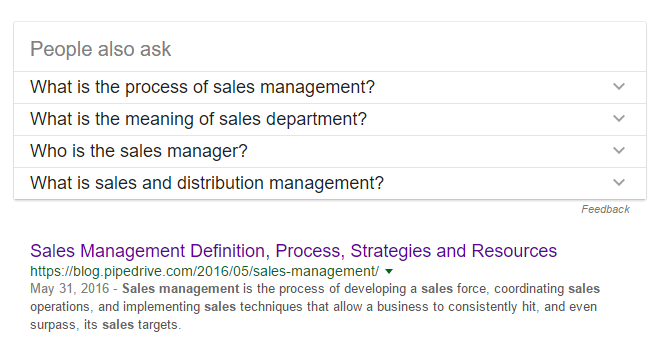
This article gets thousands of views every month. Many of the article’s visitors turn into valuable leads, saving Pipedrive thousands of dollars in advertising.
How did Pipedrive achieve these results?
I’ll share the strategy, content creation process and, most importantly, promotion tactics to get on Page One.
Individual Authorship
Pipedrive focused on creating content and building backlinks in this case study.
But if you want to future-proof your SEO, first I need to mention…
“While there’s always a grain of salt involved with Google gospel, it does seem to follow along with what we knew (or suspected) about authorship: Quality and trust signals are increasingly surrounding content and the individuals who write them.” – Matt Cutts
Matt explains this idea in more detail here:
Trust signals aren’t only based on domain authority (DA).
Authors also have trust signals.
If Arnold Schwarzenegger wrote an article about fitness with weak SEO, Google would still have incentive to rank the site.
Why?
Because Arnold is a proven authority on that subject.
If you want bodybuilding advice, you’ll likely trust Schwarzenegger.
So how do you build the same kind of authority?
It’s simple:
Place your content on as many channels as possible to develop recognition as an influencer on that topic.
JustReachOut.io is a service that lets you build authority by placing your content on other channels, ultimately making you the individual whose content ranks well for your topic.
(Disclosure: I own JustReachOut).
Individual authorship is still a developing idea in the SEO world. But, trust me, it works.
And you can lead the pack, if you…
Generate content, then tie all of that content’s authorship back to individuals so you can leverage their authority and influence.
Step One: Finding a Topic
Any SEO expert can tell you, keyword research is the foundation of a successful SEO campaign. Yet, in their rush to get started, many marketers rush their research.
The result is a keyword that is either too hard to rank for, or one that doesn’t have enough volume to justify the effort.
In this case study, I had three keyword requirements:
Enough Search Volume
Creating a kick-ass piece of content and promoting it for several months can cost thousands of dollars.
If the keyword you target gets a couple hundred searches each month, you’re not likely going to earn your investment back.
You’ll want at least the following in search volume for each stage in the buyer’s journey:
- Awareness: 10,000+ searches/month (keywords like “what is SEO“)
- Consideration: 1,000+ searches/month (keywords like “keyword research”)
- Decision: 300+ searches each month (keywords like “new york SEO agency”)
Factor in your conversion rate, product type and product price, too.
Your keyword’s CPC (cost per click) in search engine markets is also worth considering.
Besides volume and cost, consider the traffic you’ll gain:
Data shows that the first and second results get 45% of all organic traffic.
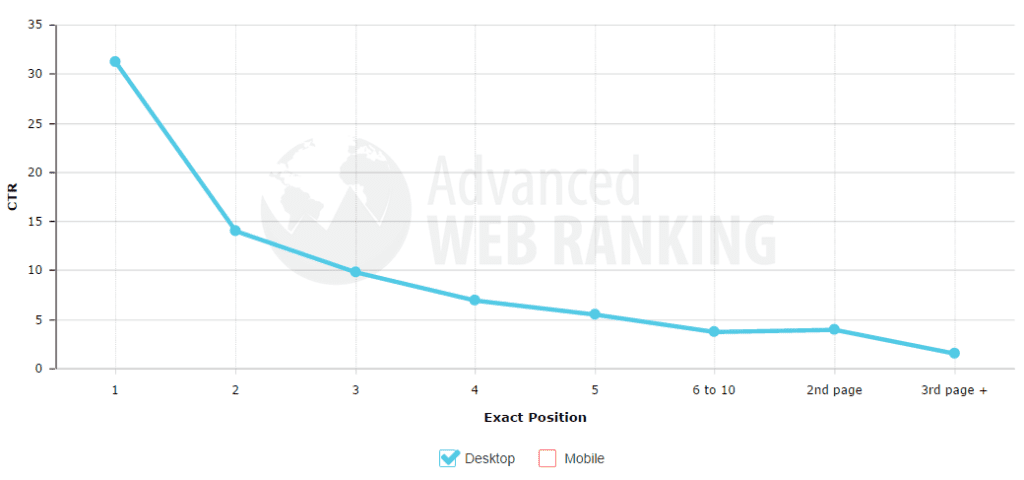
So, if a keyword has a search volume of 10,000, expect to get about 3,000 visitors from a #1 ranking.
“Making sure your search volume is between 200 and 1500 searches a month is actually a sweet spot for us when doing SEO research.” says Pawel Lawrowski, Head of Growth at Tidio Live Chat.
Make It Winnable
Some keywords are more competitive than others. Don’t spend months working on a keyword for no results.
The keyword must hit a sweet spot. That is, do you have a legitimate shot at ranking #1 for it?
How can you figure this out?
Three simple tactics:
I. Eyeball method
The fast and easy tactic is the “eyeball method.” Basically, glance at the keyword and see what kind of results are on Page One.
If you see a lot of web 2.0 pages, Blogger.com/WordPress.com links, or unrecognizable links, you’ve got a good shot at ranking well.
However, if you see big brands, Wikipedia and authority sites dominating, you’ll have a steeper climb.
II. Data-backed method
The other tactic is to look at domain and page-level metrics to gauge the competition.
The fast (and free) way to do this is to use an SEO toolbar like the Moz Bar. This toolbar will show you critical SEO metrics on the fly.
Essentially, you’re looking for keywords with low DA (Domain Authority), PA (Page Authority) and backlinks. A DA of under 50 is promising. If both DA and PA are above 50, the keyword is likely very competitive.
III. “Keyword difficulty” method
The final tactic is to use a tool like Moz Keyword Explorer to get a quantifiable idea of the keyword difficulty. Such tools factor in the metrics I mentioned above (DA, PA, etc.) and do simple on-page content analysis to quantify difficulty.
“Content marketing,” for example, is a very difficult keyword, according to Moz:

My usual workflow is to use the eyeball method to segment my keywords into broad “rankable” and “unrankable” lists. Then, I use the Moz bar or Keyword Explorer to measure the difficulty of “rankable” keywords.
Strategic Relevance
The third – and most important – factor in keyword selection is strategic relevance.
This means that the keyword must fit into your business’ broader strategic goals.
If you sell sales software, for instance, you want to rank for a sales keyword that can bring you quality leads. For example, it won’t do you any good to rank for a keyword about baseball.
I recommend listing the strategic goals for your content before you start your keyword research.
Ask yourself: What kind of results do I want from my content? What kind of traffic will help meet my business goals?
For example, a sales software company might want three things from its content:
- Establish itself as a thought leader.
- Become a trusted brand for knowledge and insight on sales.
- Capture high quality leads through sales content.
Any keyword you target must meet one or more of these goals, and there’s an easy way to automate a list of relevant keywords and variants. Using MarketMuse, a machine learning content marketing platform, you can enter your focus topic and your site URL, and it will generate a list of related terms and variants. This takes a lot of the guess work out of key word research for you, because it determines the list based on the keywords and semantic variants used in the top-ranking pages for your focus topic.
Why ‘sales management?’
This begs the question: Why did we choose “sales management” as our target keyword?
If you look closely, you’ll see that it meets all of the criteria mentioned above.
First, it has a healthy search volume. While the AdWords Keyword Planner doesn’t give exact numbers anymore, both Moz and SEMRush place the volume somewhere between 1.3k to 2.9k searches.
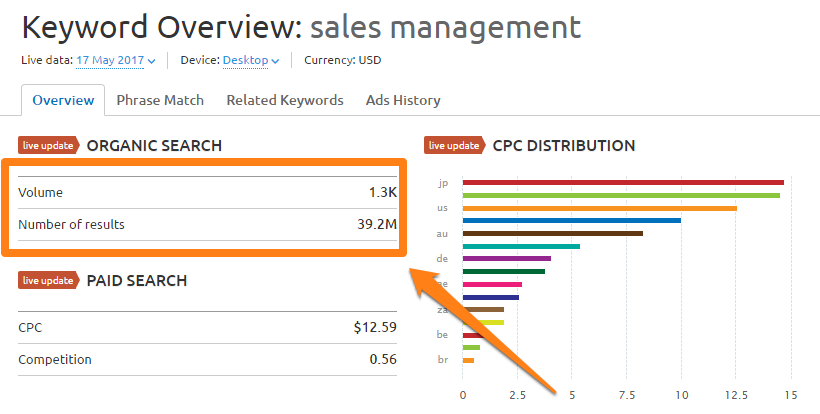
This means that a #1 result can realistically expect 400 to 1,100 visitors each month. And it’s likely to be a lot more, since the article would rank for ancillary keywords as well. In all, this can translate to several hundred leads each year.
Second, it’s a winnable keyword. Looking at Moz bar data, there are a lot of relatively low DA pages on the first page as well as a lot of content sharing sites like Slideshare or BusinessDictionary.com
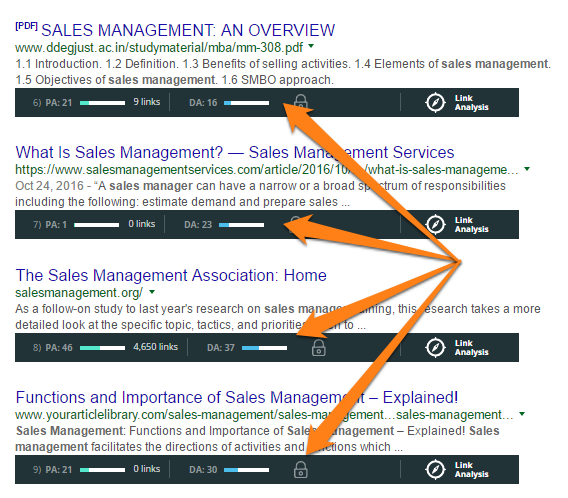
Third, it’s strategically relevant to Pipedrive. Pipedrive wanted to target decision makers – sales managers and leaders. “Sales management” is something they would search for.
In contrast, a keyword like “sales techniques” is something a sales person would look up, not a sales leader. This makes it less strategically relevant to Pipedrive’s business. This sort of strategic analysis is crucial if you want to learn how to rank higher in Google.
There is a great tutorial on keyword research over at Online Media Masters which I like, check it out here.
Once the keyword was finalized, it was time to create content.
Step Two: Create Content
Once you have a topic, it’s time to create content for it.
This might be the easiest, or the hardest part, depending on how comfortable you are with content creation.
Nevertheless, your goal should be to create something that’s at least 2x better than the competition. 10x better is ideal, but that’s usually too much for most keywords.

Ranking high in Google for a chosen keyword is simple but not easy: Make your content unique and make it better than everyone else’s.
Implement this tactic right now with our software.
Give It a Try Now!I’ll break down the steps we used to create our content below.
Research & Outline
Start by researching your topic as deeply as you can. In this case study, we relied on three sources for our research:
- Existing articles on “sales management”
- Sales management and leadership books
- Conducting interviews with sales managers on the Pipedrive team
The goal here is twofold:
- Figure out what others are already writing about and use that to guide our content
- Gather insight and hard-to-find knowledge through unorthodox sources (books and in-person interviews)
The second step is crucial if you want to stand out. While everyone uses existing articles for research, few take the time to look at books and interview real experts. This insight will make your content substantially better and more authentic than the competition.
Another thing: While researching, make sure to look at any ancillary topics you might find.
For example, when you search for “sales management” on Google, you see a bunch of related searches at the bottom of the page:


These would make for great sub-headers. Since people searching for “sales management” also search for these keywords, adding them to the content helps it rank for additional keywords and will land you more traffic.
Next, create an outline based on your research. This usually leads to more clarity and better keyword-focus.
Write the Content
If you have a detailed outline with plenty of research, writing the article should be pretty straightforward.
As someone who has written loooong articles before, my number one advice is to go all-in on writing. Meaning, if you are going to write, make sure writing is your only task for a few hours at a stretch. Don’t mix it up with other work.




If you’re feeling overwhelmed, or you need inspiration on what to write, try using a technique called mind mapping. It’ll help you dial in to your brain in a new, visual way that can help you organize your thoughts more clearly and quickly.
Implement this tactic right now with our software.
Give It a Try Now!What if you know nothing about the topic you’re covering?
In that case, think like a journalist. Don’t add your own insight; simply report insight from experts. See what other people are writing about the topic (in our case, “sales management”) and curate the best knowledge in your article.
Helpful tip: Use a tool like Noisli to create background noise. This will reduce distractions and make you more productive.
Format for Readability
Before you can make your article live, you need to take care of some formatting issues as well. Mostly, you want the article to be as easy to read as possible.
Here are a few things we did with the Pipedrive piece:
I. Bucket brigades
Notice the first line in the article:
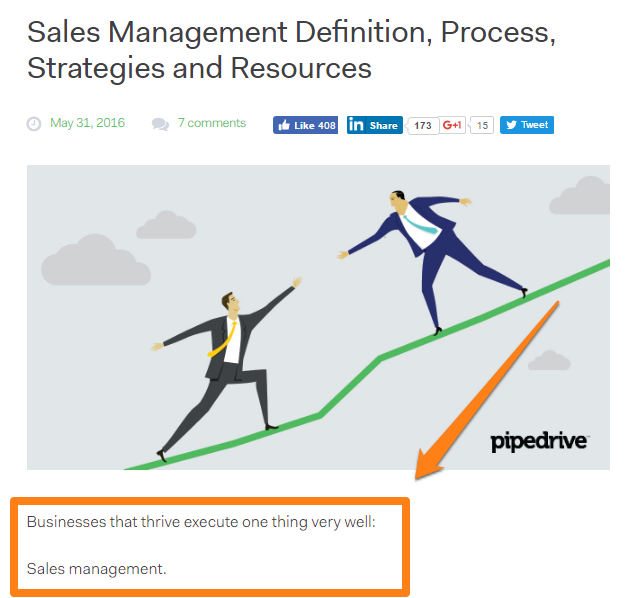

This is an example of a “bucket brigade”.
Credit to Brian Dean for popularizing this once obscure copywriting tactic. Essentially, it involves closing a sentence with a colon, then wrapping it up in another paragraph (like above).
This makes the sentence visually interesting. It also pushes readers to the next line.
Together, this can improve your on-page time and reduce bounce rate – a must for SEO.
II. Use images
Scroll down and you’ll see an image after every few paragraphs.


Images do two things:
- They add visual interest to your content
- They help break up the content into sections
Although we could have used more, an image every 4-5 paragraphs works great.
III. Keep it short
If you take a closer look, you’ll notice how our sentences are generally short (10-15 words at most). Our paragraphs are similarly concise – 3-4 sentences max.
This was still comparatively long. Some writers like Brian Dean often use one-sentence paragraphs:
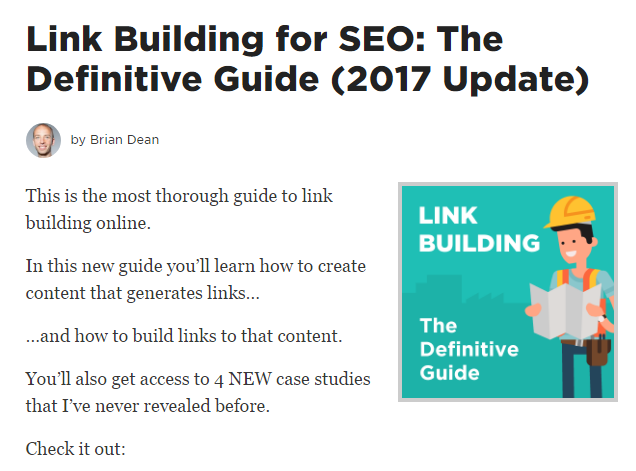

Sales management is a technical subject, so it’s not always necessary or even recommended to make sentences extremely short. But you never want to have a big wall of text, or readers will lose interest.
IV. Bullets and blockquotes
We used bullet points throughout the article:


And blockquotes in every section:
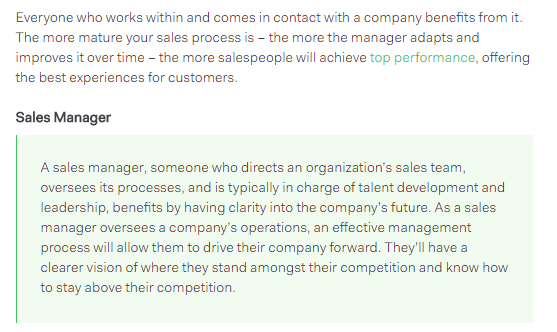

Again, this makes the article easier to read. Plus, it makes the content more visually appealing.
Do all of the above, and you should notice a steep drop in your bounce rate.
Step Three: Improve On-Page SEO
Formatting takes care of the visual aspects of the article, but if you want to rank well, there are a number of on-page factors you need to keep in mind.
Here are a few things the Pipedrive article got right:
An SEO-Friendly Title
Remember when I asked you to note ancillary topics or related searches during your research?
This is where all that comes in handy.
“Sales management” is our head keyword, but we also want traffic from related longtail keywords.
For example, searching for “sales management” on Google shows all these other things people search for related to this keyword, such as “sales management process.”
If we were to focus only on the head keyword in the title, we would lose traffic from these related keywords.
Thus, we created this title:


This covers keywords like “sales management definition,” “sales management strategies,” and “sales management resources.”
Essentially, this is an example of using SEO modifiers. Post Rankbrain and Hummingbird, Google has become smart enough to understand that “sales management definition” and “sales management strategies” can be covered under the same keyword.
Hence, you don’t have to write multiple articles. Simply adding modifiers to your title will help you rank for related keywords.
Write Better Headers
A common tip you’ll see online:
Use related keywords in your section headers (H1, H2, H3 tags).
While I’m all for it, this can make your article read terribly dry. Ultimately, you want readers to actually want to read the article.
My solution is to use keywords in the form of questions. So instead of “sales management definition,” we wrote:


As people have become more accustomed to search engines and using smartphones, search habits have changed as well. More people ask subjective questions instead of looking up keywords in Google.
By using question-based headers, you can also target these types of searches.
You shouldn’t use keywords in every header, by the way. It just makes your article feel overly optimized. For a lot of our sub-headers, we used plain English.
Use a Shorter URL
Something you might have noticed recently is the dominance of short URLs in search results. Lengthy, complicated URLs don’t seem to rank as well as they used to.
There is even research backing this up:
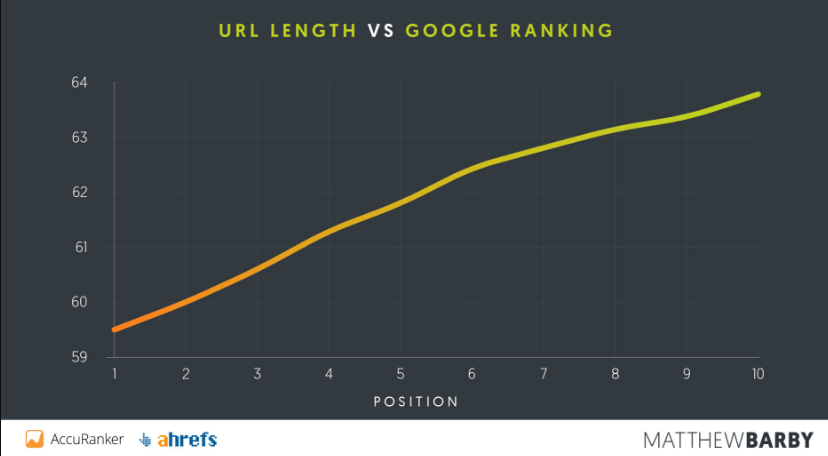

Now notice the URL for Pipedrive’s sales management article:
![]()
![]()
This wasn’t accidental – we intentionally used a shorter URL. Try doing the same for your content.
Fix Keyword Density
Keyword density can be difficult to understand. Add too many keywords and Google might see your content as “overly optimized.” Use too few and Google might not have a clear idea what your article is about.
In Pipedrive’s case, we had used our target keyword (“sales management”) too often – 48 times throughout the article. Ideally, we shouldn’t have used this more than 15 times, as per Moz’s on-page optimization tool.
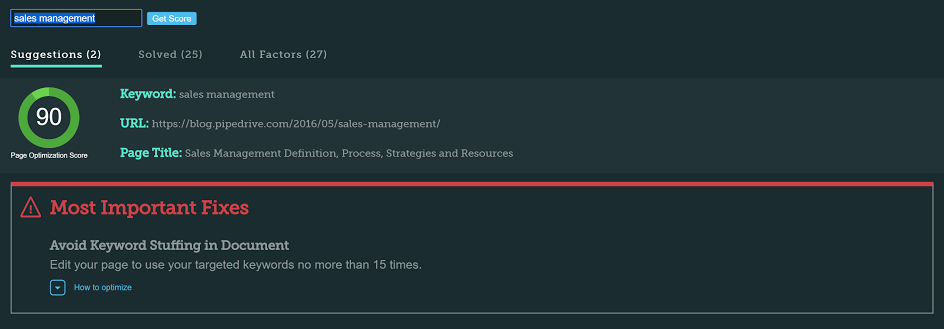

Once we cut the number of keyword mentions down to 20, we saw a gradual jump in traffic without additional link building.
I’m not saying that keyword density was the only factor, but it was important enough to have a measurable impact on rankings.
While we were doing this, we also wanted to hit more ancillary keywords in the article. But sprinkling them randomly throughout the article would just read weird.
As a solution, we decided to create a “resources” section. Here, we could add whatever ancillary keywords we wanted to target without it being weird for either readers or search engines.


If you’re struggling to fit secondary keywords in the article, consider doing something like this.
If you’ve taken all these steps, you now have a great article.
Next comes the hard part: building backlinks and driving traffic to the article.
Promotion
SEO is, by and large, still a matter of backlinks. You can have the best content in the world, but without enough backlinks, you’ll struggle to rank.
This is why once we had our content up, we focused aggressively on promoting it.
Here, I’ll share some of the tactics and strategies we used for promotion.
Identify Success Metrics
Before you start the promotion, it helps to have a clear idea of what constitutes “success” for your campaign. Far too many people have a muddled idea of “traffic” or “rankings.” This invariably affects how they go about promotion.
In Pipedrive’s case, we decided early on that we didn’t just want traffic. We wanted organic traffic. Specifically, through our target keyword – “sales management.”
While social and referral traffic are nice, we didn’t make that a priority. Consequently, we didn’t focus much on promoting the content on social networks or sites like Inbound.org.
Instead, we focused aggressively on building backlinks around terms related to sales management. Our ‘one true metric’ was our ranking for “sales management,” Everything else was just an added bonus.
Thanks to our laser-sharp focus, we avoided a lot of time wasting promotional activities.
Build Internal Links
Getting links from external sources is hard.
But getting links from your own website? That’s an hour’s worth of work.
Yet, so many marketers I know completely ignore the power of internal links. Sure, it’s not going to suddenly help you rank for “credit cards,” but it doesn’t hurt.
Essentially, internal links do two things:
- They help people discover your new content through your existing content (that already ranks well).
- They tell Google which pages you consider important.
If you have a lot of links pointing to the same page on your website, Google assumes that the page must be important.
In Pipedrive’s case, we first made a list of all our pages that had mentioned terms like “sales management,” “sales process,” “sales strategies,” etc.
You can do this by searching your site on Google, like this:
site:[url.com] “your keywords”
Here’s what we saw for “sales management” in Pipedrive’s case:
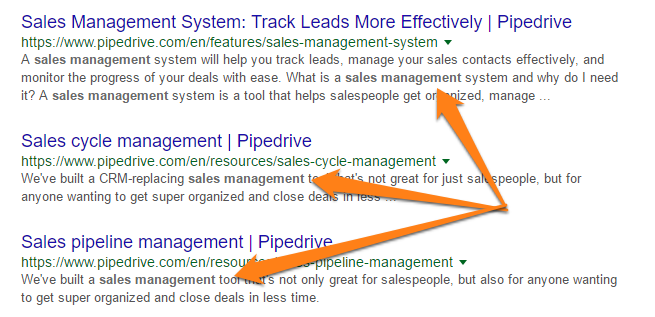

Once we had a list of pages, it was a matter of editing each page manually and adding a link to the new article.
You can easily outsource this work for under $10.
This should give you a solid foundation for content promotion. You can then move on to finding link targets and reaching out to them.
I’ll cover that in the next few steps.
Finding Targets
Every successful SEO promotion campaign begins with a list of link targets. These are websites, publications and influencers you want to get backlinks and mentions from. Once you have a list of targets, you can ask them for backlinks, guest posts, press mentions, etc.
Below, I’ll show you the process I used to find such targets.
Find Competitors
When we started this project, our aim was to create something so good that it became the definitive resource for that topic.
This is, in fact, the idea behind creating “10x content.”
So our first step in the link target search was to find competitors who had written articles about “sales management,” or closely related topics. We would then find sites that had linked to these articles and pitch them our content as a suitable alternative.
Since our content was substantially better than competitors, these sites would prefer to link to us instead. This way, we could easily earn a handful of links – enough to propel us to the first page based on the strength of our content and domain.
The easiest way to do this is to use a backlink research tool like Moz Open Site Explorer or Ahrefs.
Here are two ways you can use them:
I. Find top articles for keywords
The easiest way to find competing content is to make a list of top ranking content for your target keywords.
Then plug these pages into Ahrefs or Moz to see who has linked to them.
For example, one of the top ranking articles for “sales management” is a page from Apttus. Plugging this page into Ahrefs, we see that it has links from 8 different domains:
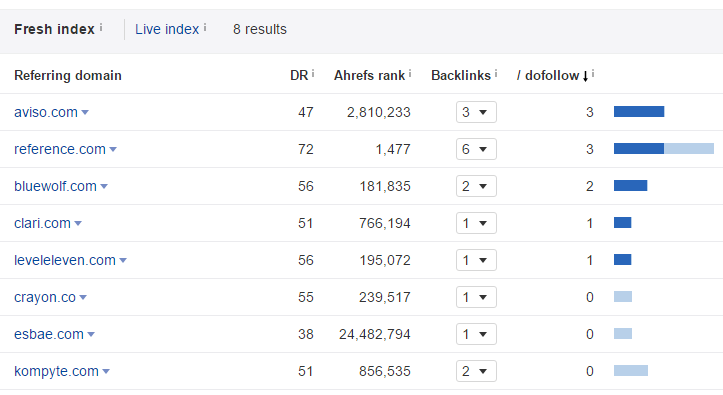

That’s not much (which also shows that Pipedrive wouldn’t need a lot of links to rank), but it’s a start.
Add all these links to a spreadsheet (use the export function in your research tool). Then do the same for other top ranking pages. Make sure to ad the DA (Domain Authority) or DR (Domain Rating) to the list, and if possible, the number of backlinks and referring domains.
Ahrefs
Ahrefs is the only tool that can show you top-performing content by backlinks for a particular keyword. This often helps find content you would otherwise miss in SERPs.
To use this:
Go to the Content Explorer in Ahrefs. Then plug in your keyword and make sure to search only “in title.”
Then sort the results by “Referring Domains.” You’ll find a lot of misleading results, such as homepages of sales tools.
But you’ll also find a few articles related to your target keyword.
For example, I found a heavily linked-to article about sales management from Entrepreneur.


This one has 167 referring domains. If we could get backlinks from even a few of these sources, we could easily get on the first page.
Again, add these results to your spreadsheet.
Find Press Opportunities
Earning a mention from a major press outlet can snowball into dozens, even hundreds of links as other publications pick up the story.
This is why I make it a point to include some media sites when building my target list.
One way to get press mentions is to find media outlets looking for stories related to your topic. Once you find an opportunity, jump in with an appropriate response. With the right opportunity, you can get a substantially high success rate.
The easiest way to do this is to use a service like HARO (Help A Reporter Out). This is a site where journalists and bloggers post requests for feedback/answers from experts. Instead of pitching journalists, you can simply answer these questions and get some great links.




Journalists on HARO are often looking for general interest stories and niche topics, including Biotech and Healthcare, Business and Finance, Entertainment and Media, High Tech, Sports, Travel, Public Policy and Government, and Lifestyle and Fitness.
Implement this tactic right now with our software.
Give It a Try Now!The problem is that searching HARO for your target keywords can be a pain. An alternative is to use a tool like JustReachOut
JustReachOut has a search tool for looking through HARO requests. Simply plug in your keyword(s) to find open requests related to it. Try to use a broad keyword (“sales” instead of “sales management”) to get better results.
For example, here are some open requests for “sales:”
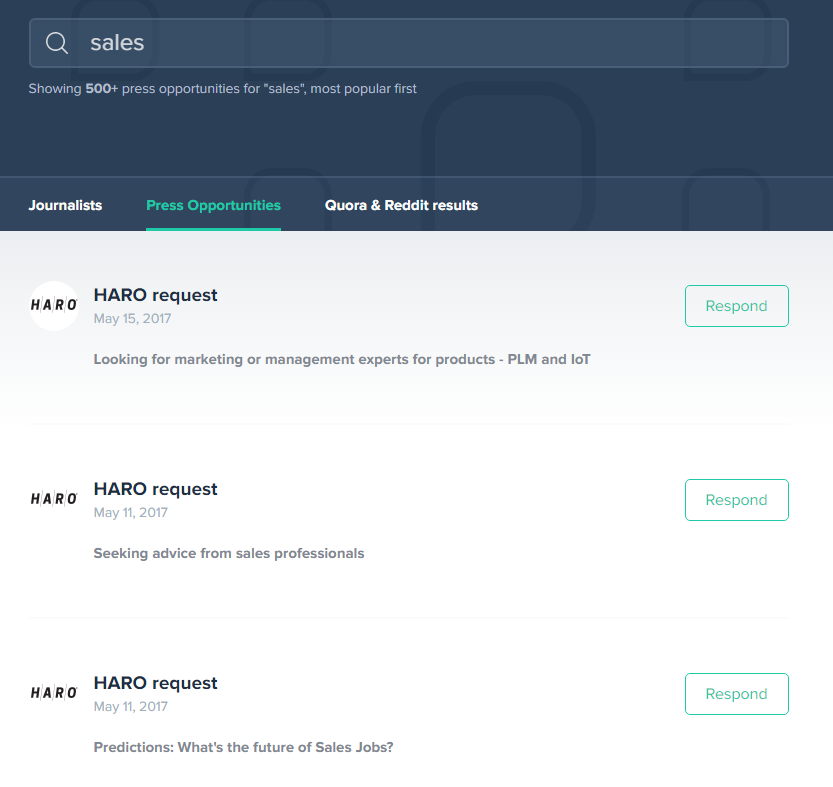

All of these would be good candidates for a response.
Broken Link Targets
“Broken link building” is one of my favorite link building tactics. It’s hard to scale but once you do find a few good targets, you’ll get some pretty solid links.
In a nutshell, here’s how this tactic works:
- Find sites that have linked to dead or non-existent pages about “sales management” (or closely related topics)
- Notify these sites about the dead/broken links
- Suggest your article as an alternative to these dead links
Broken links are bad for SEO and user-experience. Most site owners/editors are happy to hear about broken links on their site. If your page is good enough, many will also link to your page as a reward.
Finding broken links deserves a post of its own, so I won’t go into much detail here. Instead, you can read Moz’s excellent article to understand the basics.
Guest Blogging Targets
Guest blogging should be a staple of your marketing strategy. Not for backlinks or content promotion, but just to build up an audience, get valuable press contacts and develop credibility. If you’re doing it purely for SEO, you might run afoul of Matt Cutts’ now-famous diktat on guest blogging.
Pipedrive had been promoting their blog and guest blogging regularly as part of its overall marketing push. The only thing we altered was changing our links to point to the sales management article.
If you are new to guest blogging, here’s my process for finding guest blogging targets:
I. Guest posts
The easiest way to find available guest blogging spots is to look for publications that explicitly solicit guest posts.
These are usually sites with a “Write for Us” or “Guest Blogging” page.
Use this search operator to find them:
[your niche] + intitle:”write for us”
For example, searching for “sales management + intitle:’write for us'” shows this:
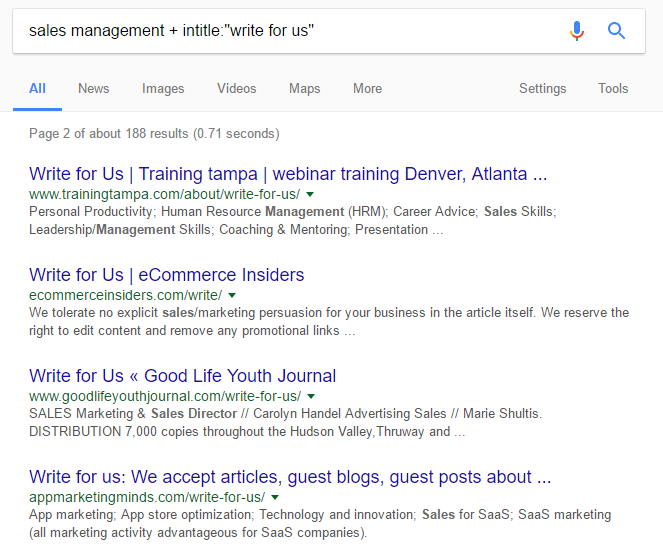

You can usually find half a dozen targets with a single search. Switch the keywords around or try variations of “write for us” to find more.
The problem with this approach is that it usually yields poor quality results. Simply put, publications that solicit guest posts are seldom the kind you’d actually want to write for.
In that case, try the second option.
II. Guest post via competitors
Instead of trying to figure out whether a site accepts guest posts, do the opposite. That is, figure out where your competitors have guest posted in the past, then contact those sites with a pitch.
To do this, find a respected individual in your industry that you know writes a lot of content. Then, use the following search to find their guest posts:
“guest post by [individual name]”
For example, looking up Neil Patel – who does a lot of guest posts – shows me all these results:
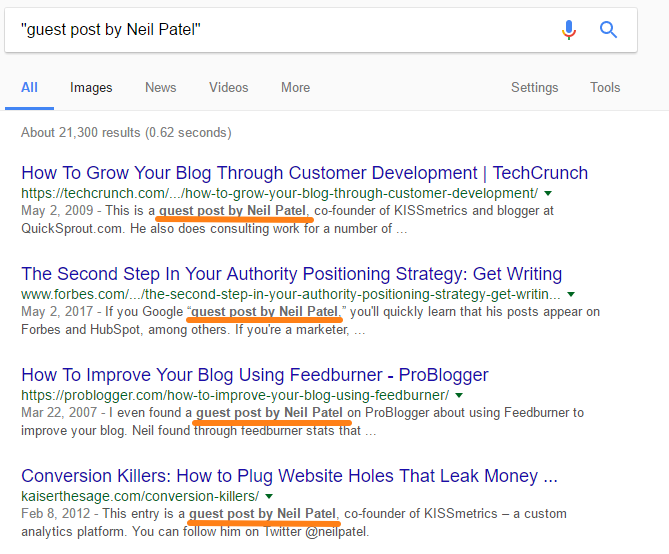

If these sites accepted posts from Neil, a few of them might accept one from you as well.
This is the fastest way to find guest blogging opportunities at top sites.
With these three steps, you should have a big list of link targets, including broken link targets.
The next step is to start your outreach.
Target List
Sending the same email to every target on your list is neither effective nor efficient. A no-name blogger with a six-month old site doesn’t require the same level of personalization as a reporter at TechCrunch.
So the next step is:
- Clean up the list
- Segment it further
I’ll show you how to do both below…
Clean up the list
Start by removing all WordPress.com and BlogSpot.com links from your list. Most sites on such free blog posts tend to be poor in quality.
Also remove very low authority sites (DA under 30). A simple filter in Excel will do.
Next, go through the list and remove any obvious affiliate sites. These are usually sites with product names or words like “review” in the domain, such as “BluehostReview.com.” Affiliate sites are unlikely to link out to others.
More often than not, you can tell these low quality affiliate sites just by looking at them. For example, this is a clear example of an affiliate site:
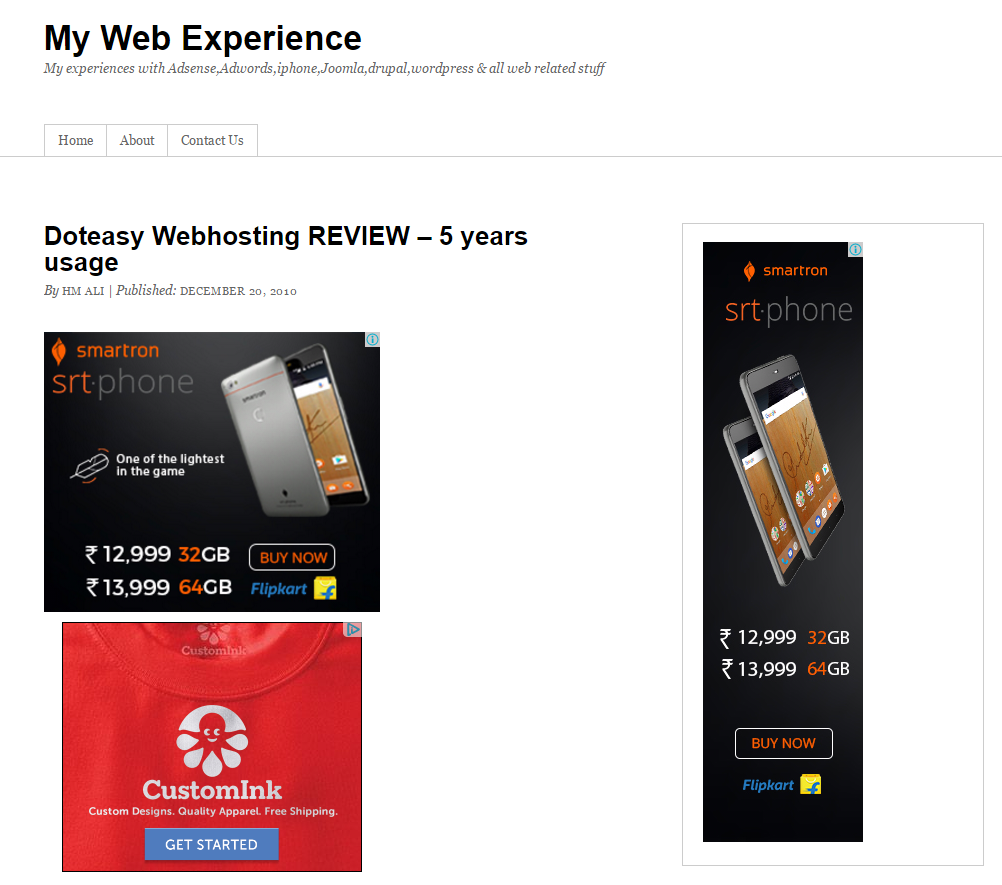

The ads above the fold and the old, outdated content signal to us that it’s a low quality affiliate site.
Once you’ve cleaned up the list, you can start segmentation.
Segment the List
For Pipedrive, we had three segments:
- Segment #1: Generic websites with poor domain authority (DA under 40).
- Segment #2: Mid-level sites with established authority and decent name recognition in the community (DA 40-60).
- Segment #3: High-level sites with a large social following and/or domain authority (DA 60+).
Use your own judgment when making these segments.
Category #3 sites will be obvious to you if you’ve spent any time in the industry. In the marketing niche, for instance, HubSpot, ContentMarketingInstitute, Copyblogger, Quicksprout, etc., would fall in this category.
Don’t fret too much over this. Segmentation is for your own benefit. Even if you get a few sites wrong, it shouldn’t have a big impact on your success.
Find Email Addresses
Before you start pitching, there’s a critical step you need to take first: finding email addresses.
This step has become much easier in the last couple of years thanks to sales prospecting tools like Hunter.io and VoilaNorbert.
I’ve covered finding email addresses in an earlier post so I won’t go into much detail here.
In a nutshell, here’s what you should do:
1. Find the Right Person to Contact
You want to make sure that you contact the right person for each article in your list of targets.
In most cases, the following holds true:
- If the article is by a contributor or guest blogger, contact the site editor or site owner, in the case of smaller sites/blogs.
- If the article is on a media site, such as Forbes, contact the relevant section editor.
- If the article is on a business or startup blog, such as Pipedrive, contact the editor or content manager. For very small businesses, you can even contact the marketing director.
For example, one of the links we won was from Process.st.


This article was written by Ben Mulholland. A quick Google search for “Ben Mullholland” shows that he is a content marketer at Process.st
This would make Ben a great candidate to contact for a link.
Do this for all the links in your target list.
Hunter.io
Once you have a list of names, use Hunter.io to find their email addresses.
Hunter will find the email pattern used on a domain. For example, here’s what it shows for TechCrunch:
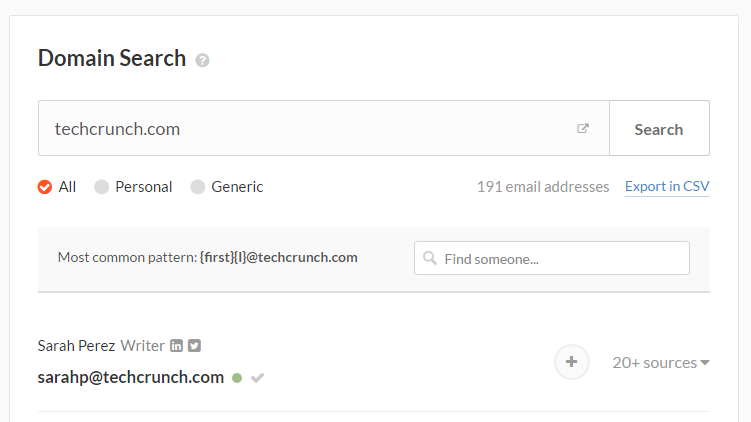

Use this to find the email address of every person on your list of link targets.
In the next step, we start sending outreach emails.
Outreach Emails
You now have a well-segmented list and email addresses for every contact. Now it’s time to create templates and start sending emails.
For Pipedrive, we created three different email templates for every segment. Each of these templates had a different request. Fine tune these templates if you want to know how to rank higher on Google.
First Template
This email was sent to low-priority targets on our list. The objective was to get a relevant backlink.
Given the target quality, we only personalized the following:
- Recipient name
- Recipient website
- Target URL (which we wanted a backlink from)
You’ll likely send hundreds of such emails. We used mail merge in MixMax to mass send these emails quickly (more below).
For a template example, refer to my earlier post on cold email templates.
Second Template
We sent this email to mid-priority targets. The objective was to get “feedback” first. Essentially, we wanted to start a conversation that might lead to a backlink. We assumed this would be the first in a number of emails as well as ongoing, long-term contact.
We personalized the following:
- Recipient name
- Recipient website
- Target URL
- A personalized line about the recipient
For a template example, take a look at this:


If you’ve read my earlier posts on cold emails, you’ll recognize the tactics used here. Essentially, this email:
- Mentions respected businesses the recipient is familiar with to break ice.
- Mentions “something missing” in the subject line, then in the body copy to grab attention.
- Closes with a request for feedback as opposed to a direct backlink. This makes you come across as a real person, not an SEO spammer.
Third Template
This is the email you’ll send to high-priority targets. The word “template” is a little misleading, since you’ll likely have to personalize your messages to get any chance of a response.
Top writers at TechCrunch or Copyblogger aren’t going to respond to mass-mailed link requests.
The objective of this email wasn’t to earn a backlink. It was to initiate a relationship. As such, it aligns more with PR than SEO.
Instead of repeating my PR strategy here, I’ll point you to my recent guide on getting PR.
The thing to remember is that most people aren’t going to add a link for you off a single email. Plus, a one-off link isn’t even what you should really be targeting — building a relationship with the editor, writer, journalist, and getting your brand familiar with them, building trickle-down links that 10x your original goal.
So adding a simple calendar scheduling link to increase your chances at building a real relationship is usually a good idea. Using this as an opportunity to connect quickly with your prospects and add a real, personalized touch is an awesome idea for these types of emails.
Automate Personalized Emails
You can’t really send hundreds of personalized emails without help. My favorite tool for this is MixMax.
MixMax is a “sales automation tool,” but I find it perfectly viable for outreach as well, mostly because of these three reasons:
- You can track email opens and clicks
- You can use mail merge to personalize emails in bulk
- You can create templates to send mails quickly through Gmail
For example, if you wanted to send a personalized email through MixMax, all you’ll have to do is create a message like this:
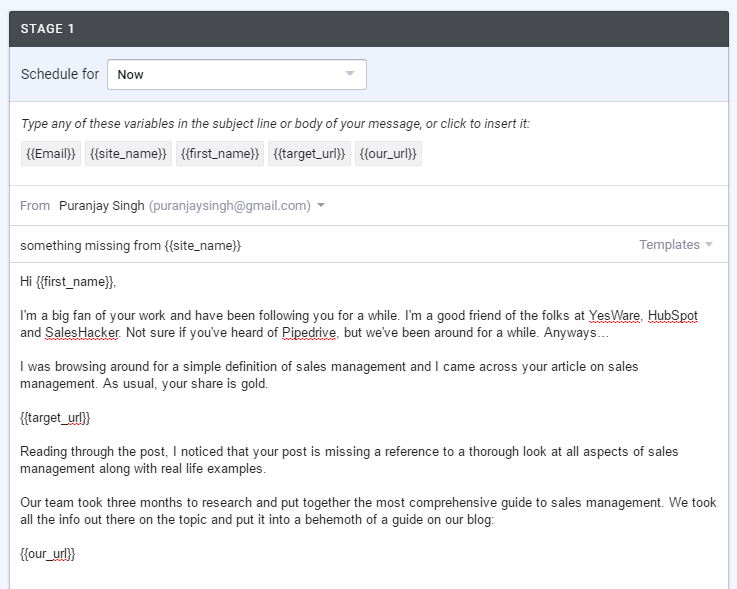

The parts within {{ }} can hold personalized data.
You can then upload a CSV file with all the data mentioned above (make sure the variables match). And MixMax will use mail merge to create personalized emails on the fly.
Even better, you can save each email as a template. Then, when you log into Gmail, you can create an email using the template drop down menu.


This will save you countless hours of manually sending emails. It’s a MUST if you want to do outreach at scale.
Be Sure to Follow-Up
You usually win backlinks on the follow-up, not the initial email.
If you want to succeed with outreach, and if you haven’t gotten a response, make sure to send a follow-up email within a week of the first one.
Don’t overdo follow-up – once is enough. More than that without any response will make you look desperate.
MixMax will help you with your follow-ups, too. You can create automated sequences to send out after X number of days.
Use this to automate your follow-up.
Enjoy the Results!
Within three months of our outreach efforts, we were ranking on the first page of “sales management.”
Of course, your outcome might differ. But it’s not impossible to imagine similar rankings if you follow all of the steps above.
The hardest part is correctly doing outreach. Most marketers can create content. But few take the time to promote it properly. Master this part, and you’ll never be short of SEO success.
Try the strategies I’ve recommended, and let me know your results below!
- Results at a Glance
- Individual Authorship
- Step One: Finding a Topic
- Enough Search Volume
- Make It Winnable
- Strategic Relevance
- Why ‘sales management?’
- Step Two: Create Content
- Research & Outline
- Write the Content
- Format for Readability
- Step Three: Improve On-Page SEO
- An SEO-Friendly Title
- Write Better Headers
- Use a Shorter URL
- Fix Keyword Density
- Promotion
- Identify Success Metrics
- Build Internal Links
- Finding Targets
- Find Competitors
- Ahrefs
- Find Press Opportunities
- Broken Link Targets
- Guest Blogging Targets
- Target List
- Clean up the list
- Segment the List
- Find Email Addresses
- Hunter.io
- Outreach Emails
- First Template
- Second Template
- Third Template
- Automate Personalized Emails
- Be Sure to Follow-Up
- Enjoy the Results!
I won’t agree you need a high number keyword to drive 1000s of visitors to your page. I have a page which target a keyword with 300 searches/month and now is driving almost 3000 UV/month.
On first page you will only find big ecomm and manufacturers amazon, walmart, ajmadison etc
Thank you for this article.
Nice! I totally agree with you, no high volume keywords are needed. Curious which word are you ranking for?
Brilliant post. No fluff, no hype, no hyper-inflated claims. Very detailed and digestible. A+ from Kennedy Studio!
Thanks Robert! At first when I saw your name and domain name I took a second look at the comment haha, then realized you were someone else, haha! I see a .nyc domain name though, nice, I’m in NYC as well. Where are you based?
Dmitry, I work out of my place in Ditmas Park (Brooklyn), and am looking for a co-working place. May look at your place!
PS: I’m thinking of doing a case study based on your post today. Will be sure and keep you in the loop if I do.
Cheers,
Bobby
Oh nice! That’s close by. I work from Bond Collective here near Whole Foods close to Park Slope and Gowanus area. Small world! Let me know if you want an intro to them, they’re a friendly bunch, you can come by check it out, work for free for a day.
Let me know what your plans are in terms of the study, happy to support/help! Will this be for your own blog?
Yes, it will be (on my robertkennedy.nyc site). I’m a long-time Tech Writer launching a freelancing career as a copywriter (for tech companies). I’ll definitely be in touch.
Thank you for the incredibly comprehensive article Dmitry! I run a brick and mortar music technology production training centre called Mile High Sounds in Malaysia. The keywords of interest are:
Music production courses
Sound engineering courses
Ableton Live
Sure, happy to help! You’ve got some good keywords, how do the first page Google search results look for these keyword in Malaysia? Any weak pieces of content you see ranking in top 10 spots? Think you can write something better?
Hi Dmitri – we spoke a year or two back, and I still follow your posts. Some of your strategies we use in some shape or form. Some cool new ideas in this post. We’re going to try them!
If you have ideas around “African safari”, “{country} safari”, and the related set of higher-intent longer-tail terms — drop me a mail.
It would be good to bounce some ideas and possibly work on a project together. We have a team in-house that knows our product and can develop good content — even interactive content like our wildebeest migration tracking app https://www.discoverafrica.com/herdtracker/
Hey Hey Andre! I do remember you! Of course! How are you! Lets def connect. Can you shoot me a note over email? Be good to chat!
Hi Dmitry,
Thanks for your prompt reply.
Can we perhaps take this over email? I’m not sure how to reach you directly but it would be great if you could drop me a line via http://www.milehighsounds.com/contact and we can take it from there.
Hey Reuben, feel free to shoot me a note through contact on my site!
Great article!
These step by step actions with proven results are what separates the good blog posts from the great.
Amazing stuff!
Thank you Clarke! What are you working on out of curiosity?
Funny, I was just talking to a SEO agency that sent me a proposal with a very similar strategy to build out my content for me and wanting to charge thousands for it on a per monthly basis. I’m getting close to finally launching a blog on my site (always the last thing on the todo list) to hopefully rank for some important local directory keywords. This is a great step-by-step guide to follow, now I just need to do the work. Very helpful Dmitry, thanks.
Thanks Jeff! That was precisely the reason I wrote this article so that founders can try to do this on their own or at least direct someone who they hire to follow this process instead of blindly outsourcing this stuff to an agency. What are you trying to rank for?
-Dmitry
Beautifully done and well explained. But stating number of words to use while writing would have been improved this article and cleared some of my doubts.
You stated about on page tool by moz but i don’t have a pro account them. To know is there alternative tool to check On-page score other than yoast?
Hey Abdullah,
Happy to answer your questions. 2000+ words is usually the sweet spot in terms of article length. Brian Dean ran a study recently where he found that the average Google first page article contained nearly 2,000 words. See here:
https://thenextweb.com/insider/2016/03/16/5-actionable-seo-tactics-based-actual-data/#.tnw_xavGS4co
You can check your authority here: http://www.checkmoz.com/
I like to use https://ahrefs.com/
Let me know if this answers your questions?
I’m curious, how long have you been running your blog?
-Dmitry
Just saw the same post? At Moz
Is it rewritten or something? How’s it not being hit with dupe content penalties?
Hey Vincent, yes I published the original article about this case study on Moz in April of this year, this blog post on my site is a bit different, it’s not the same content, we dig deeper into some parts of the process vs. Moz one. Broadly through it’s the same process which I describe in both posts.
Curious – have you done much work similar to this process I described?
Dmitry, excellent content here. The value in this article is incredible and I appreciate you sharing.
What do you think is a rough estimate of the hours you put into the Pipedrive article? I’m a firm believer in reaping what you sew and imagine this takes a lot of time. Just curious for the sake of planning ahead.
Hey Andrew, thank you for the kind words. Yes, you guessed it it took a lot of blood sweat and tears. Give or take 4 months, working at very least three hours per day on this stuff, some days much more. Does that give you a good ballpark estimate?
What are you trying to rank for?
Similar, but not exactly. Been using search operators in such a manner for the better part of a decade and liked your twist on that. I have never been on the outreach end though – I stay more technical.
Another big plus take away this is how you broke down the keywords to Awareness/Consideration/Decision – well put.
Last but not least was Mixmax – that’s quite a few tools in one (email track/email send scheduling/calendly/a bit more). By far my favorite takeaway. That’s even without using it for outreach and its’ templates in the sense that you have shown.
I first heard of the blogging around 10 years back ,when I picked a book called blogging for dummies at the local library , I recently started the blogging and was trying to understand the SEO thing by myself .great article .everday learning something .most importantly I don’t want to spend money for so called SEO guys seems to be trying to figure out SEO itself. I am into travel niche and my simple understanding is to follow the old school methods of writing a good piece of essay .do it it by heart .google will simply find you . What Google wants is to give the customers good search result relevant to their inquiry .
You’ve hit the nail on the head Supun, AMAZING content is what Google likes to see. No amount of backlinks or crazy tricks can take away a ranking spot for AMAZING content. That said there does need to be some strategy around which keywords and topics you want to write about and what are your chances of ranking for them. Here check out my two latest articles on this topic, this should help you nail down your strategy: https://moz.com/blog/case-study-ranking-high-volume-keyword and http://semrush.com/blog/using-guest-blogging-as-a-link-building-strategy/
Thank you Dmitry .i have actually read both of those articles ,which I am going to use in my future link building strategies .your website may be my first link .
Cheers, thanks Supun! Feel free to ask any questions as you get going with implement some of this stuff!
I am going to create an article about doing SEO for a particular industry and it is going to be huge. I am sure this article will help me rank for my target keyword.
Haha, you’re very cryptic in your response. 🙂 What industry are you going after?
Hey Dmitry, I’m trying to tank for “mobile CT” and “mobile CT scanner” at CatalinaImaging.com. Our home page currently sits at #10 for “mobile ct” and #11 for “mobile CT scanner”. The #1 spot is an article from a competitor. No backlinks point to the article, but their DA is quite a bit higher than ours.
Hey Andrew, yup, DA has a lot to do with ranking, you want to go for keywords which has similar DA sites (to yours) ranking at #1. Maybe you can get a bit higher if you accumulate some links and improve your content. Do more of this: http://backlinko.com/on-page-seo
Thank you for the insight
No prob. Shot over any questions as you start to implement this stuff.
Hello Dmitry, thanks for the post. I hope it helps me get more link juice and more rankings from Google.
-Fina
I find myself unable to leave your blog! I can’t stop reading it! I must say you have a very unique voice in writing, which I personally appreciate.
Thanks for sharing about ranking factors benefits, but want to know about one thing I did not understand the actual way of keyword ranking factors that is very important for me to know.
Please specify about it.
Thanks for the comment Amjad, can you clarify the part you did not understand and also your specific question?
fantastic post thanks for sharing information
I really enjoyed this. It’s got my juices flowing and my thinking cap on in terms of how evergreen SEO practices are getting closer and closer to the principles of relationship marketing.
Thank you for this big article. Yes ranking for high volume for me is like… impossible… since I don’t have a website which is ranked high already. I see websites which rank have at least 10 or 20 score. I guess I need to work on my rank?
Thanks for the note Julien. You’re talking about domain authority I am guessing?
That’s really interesting, I have noted many points that I am not aware of. It’s a valuable post Dmitry which I am actively searching for.